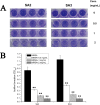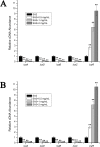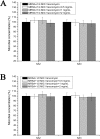Effects of stigmata maydis on the methicillin resistant Staphylococus aureus biofilm formation
- PMID: 30828488
- PMCID: PMC6396744
- DOI: 10.7717/peerj.6461
Effects of stigmata maydis on the methicillin resistant Staphylococus aureus biofilm formation
Abstract
Background: Mastitis is an inflammatory reaction of the mammary gland tissue, which causes huge losses to dairy farms throughout the world. Staphylococcus aureus is the most frequent agent associated with this disease. Staphylococcus aureus isolates, which have the ability to form biofilms, usually lead to chronic mastitis in dairy cows. Moreover, methicillin resistance of the bacteria further complicates the treatment of this disease. Stigmata maydis (corn silk), a traditional Chinese medicine, possess many biological activities.
Methods: In this study, we performed antibacterial activity assays, biofilm formation assays and real-time reverse transcription PCR experiments to investigate the effect of stigmata maydis (corn silk) on biofilm formation and vancomycin susceptibility of methicillin-resistant Staphylococcus aureus (MRSA) strains isolated from dairy cows with mastitis.
Results: In this study, the aqueous extracts of stigmata maydis inhibited the biofilm formation ability of MRSA strains and increased the vancomycin susceptibility of the strains under biofilm-cultured conditions.
Conclusion: This study proves that the aqueous extracts of stigmata maydis inhibit the biofilm formation ability of MRSA strains and increase the vancomycin susceptibility of the MRSA strains under biofilm-cultured conditions.
Keywords: Biofilm; Bovine mastitis; MRSA; Stigmata maydis; Vancomycin.
Conflict of interest statement
The authors declare that they have no competing interests.
Figures





Similar articles
-
Methicillin resistance genes and in vitro biofilm formation among Staphylococcus aureus isolates from bovine mastitis in India.Comp Immunol Microbiol Infect Dis. 2019 Jun;64:117-124. doi: 10.1016/j.cimid.2019.02.009. Epub 2019 Mar 1. Comp Immunol Microbiol Infect Dis. 2019. PMID: 31174686
-
Effect of ZnO nanoparticles on methicillin, vancomycin, linezolid resistance and biofilm formation in Staphylococcus aureus isolates.Ann Clin Microbiol Antimicrob. 2021 Aug 21;20(1):54. doi: 10.1186/s12941-021-00459-2. Ann Clin Microbiol Antimicrob. 2021. PMID: 34419054 Free PMC article.
-
Ethanol extract of Sanguisorba officinalis L. inhibits biofilm formation of methicillin-resistant Staphylococcus aureus in an ica-dependent manner.J Dairy Sci. 2015 Dec;98(12):8486-91. doi: 10.3168/jds.2015-9899. Epub 2015 Oct 9. J Dairy Sci. 2015. PMID: 26454299
-
Risk Factors for the Occurrence of Methicillin-Resistant Staphylococcus aureus in Dairy Herds: An Update.Foodborne Pathog Dis. 2020 Oct;17(10):585-596. doi: 10.1089/fpd.2019.2638. Epub 2019 Aug 28. Foodborne Pathog Dis. 2020. PMID: 31433237 Free PMC article. Review.
-
Correlation Between Biofilm Formation and Antibiotic Resistance in MRSA and MSSA Isolated from Clinical Samples in Iran: A Systematic Review and Meta-Analysis.Microb Drug Resist. 2020 Sep;26(9):1071-1080. doi: 10.1089/mdr.2020.0001. Epub 2020 Mar 10. Microb Drug Resist. 2020. PMID: 32159447
Cited by
-
Nanocomposite system with photoactive phloxine B eradicates resistant Staphylococcus aureus.Heliyon. 2024 Jun 26;10(13):e33660. doi: 10.1016/j.heliyon.2024.e33660. eCollection 2024 Jul 15. Heliyon. 2024. PMID: 39071577 Free PMC article.
-
Exploring the Action Mechanism of the Active Ingredient of Quercetin in Ligustrum lucidum on the Mouse Mastitis Model Based on Network Pharmacology and Molecular Biology Validation.Evid Based Complement Alternat Med. 2022 Jun 10;2022:4236222. doi: 10.1155/2022/4236222. eCollection 2022. Evid Based Complement Alternat Med. 2022. PMID: 35722145 Free PMC article.
-
Alternatives to antibiotics for treatment of mastitis in dairy cows.Front Vet Sci. 2023 Jun 19;10:1160350. doi: 10.3389/fvets.2023.1160350. eCollection 2023. Front Vet Sci. 2023. PMID: 37404775 Free PMC article. Review.
-
Editorial: Green Veterinary Pharmacology and Toxicology: a "One Health" Approach milestone.Front Vet Sci. 2024 Sep 9;11:1476877. doi: 10.3389/fvets.2024.1476877. eCollection 2024. Front Vet Sci. 2024. PMID: 39315082 Free PMC article. No abstract available.
References
-
- Atshan SS, Nor Shamsudin M, Sekawi Z, Lung LT, Hamat RA, Karunanidhi A, Mateg Ali A, Ghaznavi-Rad E, Ghasemzadeh-Moghaddam H, Chong Seng JS, Nathan JJ, Pei CP. Prevalence of adhesion and regulation of biofilm-related genes in different clones of Staphylococcus aureus. Journal of Biomedicine and Biotechnology. 2012a;2012:1–10. doi: 10.1155/2012/976972. - DOI - PMC - PubMed
LinkOut - more resources
Full Text Sources

